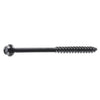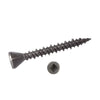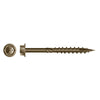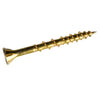 View All
View All
Wood screws are a broad category, though, and you’ll find different types that offer a wide range of heads, drives, gauges, lengths, etc. Most all wood screws feature an aggressive heading that is ideal for really holding attachments, but you’ll have to choose the best type of wood screw to get the job done for you.
At FMW Fasteners, we offer a huge selection of wood screws for sale that allows you to find exactly what you need, no matter the nature of your upcoming project. When you need wood screws, trust the quality products and wide selection you’ll find at FMW Fasteners.
When you want to join one piece of wood with another, you probably know screws are the best way to do it. However, determining the right material, length and gauge of the screws can be more challenging — especially if you're not a professional builder or carpenter. To help out those less experienced in the art of woodworking, we've put together a helpful guide that answers the most common questions about wood screws.
FAQs About Wood Screws
Some of the most frequently asked questions about these fasteners include the following.
1. How to Join Two Pieces of Wood With Screws?
To connect two pieces of wood with traditional wood screws, follow these five steps:
- Find screws with the correct length. Using screws of the right size is essential. A screw that is too long will come through the surface of the second piece, ruining the finish, and if the screw is too short, the fixing will not be sufficiently strong. The screw length you want should be equivalent to the depth of the top piece, plus half the depth of the bottom piece. That means the screw will go entirely through the top piece and just halfway through the bottom one. We will talk more about how to select a screw with all the correct specifications later on.
- Mark the hole. Using a pencil, mark the exact center point where the screw will go through the wood.
- Drill a pilot hole. To prevent the wood from splitting, you'll want to drill a pilot hole. To do so, find a drill bit that is roughly the same width as the screw. Make sure it is no wider, as that may prevent the screw from gripping the wood securely. Drill through the top piece, starting at the cross you drew with the pencil. Then, using a bradawl — or a drill bit, if the screw size is 6 or higher, make a narrower pilot hole in the other piece. You shouldn't drill down too far — just enough so that the screw can get a start.
- Use a countersunk bit if using a countersunk screw. A countersunk screw has a head or top that goes into the wood. If you plan to use one of these, make sure to use a countersunk bit when drilling the pilot hole, which will make room to sink the head of the screw.
- Screw in the screws. Make sure to tighten all screws equally — differences in tightness may cause the wood to twist due to the uneven distribution of tension.
Also, keep the following pointers in mind:
- Use the screw appropriate for wood. Picking the correct screw for the job can be challenging, especially if you're not a professional woodworker. Some screws are not well-suited for wood. The most commonly used screw among woodworkers and carpenters is the countersunk screw with a cross-slot head. Assuming you are using the correct screwdriver and know how to drill screws into wood correctly, it won't slip and cause damage to the wood's surface.
- If joining certain types of wood materials, use specialized screws. If you're joining two pieces of fiberboard, chipboard or similar, you should use specialized chipboard screws. These feature deep-cut, sharp-edged threads that extend to the screw's shank. These have excellent strength and grip, and can also fasten wood.
2. What Size Screw Should I Select?
Figuring out the right gauge and length of a wood screw can be a challenge, and you must consider factors like:
- The wood type
- Material of the screw
- Shear versus lateral forces
- The presence of pilot holes
Luckily, general guidelines will help you buy and use the right-sized screw for your project.
Gauge, Length and Pilot Holes
Learning the basic principles behind wood screw technology will help you tremendously with choosing the right screw size.
- Gauge: The gauge, or thickness, of a wood screw must be sufficiently thick to grab onto both boards. If the gauge is too thin, it may come right out of the wood. If it's too thick, it may cause the wood to split, making it useless.
- Length: A wood screw must be sufficiently long to securely hold two boards together. If the screw isn't long enough, the boards may come apart. Conversely, if it's too long, the screw will pop through the other side.
- Pilot holes: As mentioned above, it's generally a smart idea to drill a pilot hole. Doing so is often an essential part of working with hardwoods, like walnut and oak, which are more prone to splitting. Softwoods, like cedar or pine, are not as likely to split.
Keep in mind that wood screws gain power in two principal ways: by friction and by the pressure of the wood fibers that grip the threads. If you cut away fibers and remove them — which is what happens if a pilot hole is too big — you will significantly weaken the screw's holding power.
Withdrawal vs. Lateral Loads
To hold fast, wood screws must have sufficient thread driven into the bottom board. The length of thread inserted into the bottom board depends on the forces — either withdrawal or lateral — that the boards will experience once they are in use. Below is a brief description of each.
- Withdrawal loads: If the forces applied to the boards want to pull them straight apart, which is known as withdrawal pressure, make sure there are plenty of screw threads inside the receiving board. There should always be at least one or one and a half inches of thread in the bottom board — assuming, of course, that this length won't poke through to the other side. If you require short screws to avoid this issue, you'll have to compensate by driving in more screws.
- Lateral loads: If the forces acting on the boards apply lateral pressure, which is also called shear pressure, you'll want to use a thicker screw than you'd choose otherwise. Lateral pressure is where two boards attached flat to one another are subject to a sliding motion. A common example of this is kitchen cabinets screwed to wall studs.
Steel Screws vs. Utility Screws
Steel and utility screws are also called deck screws. We'll describe the fundamental differences below.
- Utility screws: Utility screws are best for outdoor woodworking projects and framing. They come in various types of steel, including corrosion-resistant metals designed to withstand the chemicals found in treated lumber. You'll usually find these screws sold by length.
- Stainless steel and steel wood screws: The bodies of these screws are thicker, and they are often good for indoor furniture and woodworking projects. When buying screws, you will notice them labeled by their length and their gauge. The gauge refers to the screw shaft's thickness. The larger the gauge number, the thicker the screw shaft. Utility screws tend to be either #8 or #10 gauge, while steel and stainless steel screws come in a much broader range of gauge diameters.
Orientation of the Wood Grain
The length and quantity of screws that you use will depend on the direction of the grain in the receiving board. Generally speaking, when a screw joins two boards by going across the grain, the screws don't need to be as long as when the screws go along the grain. If you have to screw going along the grain, there should be a minimum of two inches of thread in the receiving board.
Use the following tips as a general guide:
- For most utility tasks, an #8 gauge deck-type screw should work.
- For tasks that don't require as much strength or when you have to attach two three-quarter-inch-thick boards by going across the grain, a one-and-a-quarter-inch screw should do the trick.
- Have some two-and-a-half-inch deck screws on hand for when you have to screw into the end grain.
- Have a few three-inch screws ready to attach into boards that are end-grained or for situations that require extra power.
- Finally, in situations where the boards will be under a lot of shear pressure, you should have some lag screws measuring one-quarter inch in diameter.
3. What Screw Should I Use for a Wood Fence?
The size of screws you'll want to build your wood fence with will depend on the type of wood and style of fence. Below, we've listed the most common types of screws for wood fences and the applications each is best suited for.
- Deck screws: Deck screws, which are also called green screws, are an excellent choice for pressure-treated wood. These screws feature an epoxy coating that serves to protect the wood from corrosion. They come in two types: square drive or Phillips head. They are also available in various lengths and diameters. Before driving in the screw, make sure to drill a pilot hole first — this will help to prevent the wood from splitting.
- Galvanized screws: When working with redwood, cedar or other types of untreated wood, we highly recommend galvanized screws. They have a zinc coating that keeps the wood from rusting, discoloring or staining. They're available in one-, five- or 25-pound boxes.
- Lag screws: Lag screws are good for all wood fences and heavy planking. They have hexagonal heads and come in galvanized, silicon bronze, stainless steel and uncoated steel.
- Silicon bronze screws: Silicon bronze screws feature a rust-resistant metal alloy that is excellent for wood fences built near an ocean, riverbank or lake.
4. What Kind of Screws Can Be Used in Pressure-Treated Wood?
Pressure-treated lumber uses contains two copper-based wood preservatives: copper azole and alkaline copper quaternary. While these preservatives are highly preferable to the arsenic-based compounds of years past, they can rapidly corrode normal steel screws, which will result in premature structure failure. However, as long as you use one of the following corrosion-resistant fasteners, you will have nothing to worry about.
- Galvanized with zinc: To use galvanized steel screws with copper-treated wood, they must get dipped in molten zinc at a temperature of 850 degrees Fahrenheit. They must also meet the ASTM A153 standard, which guarantees a high-quality zinc coating, and the G-185 standard, which guarantees a sufficient amount of coating.
- Stainless fasteners: You can use stainless steel fasteners in grades 304 or 305 when working with copper-treated wood in most regions, but if you live in a coastal region, you should use grade 316. Keep in mind, however, that stainless screws can be five to 10 times more expensive than the equivalent galvanized screws. Stainless steel screws also have the unique disadvantage of being incompatible with galvanized structural connectors, due to the damaging chemical reactions that could result.
- Polymer-protected: Steel screws coated with polymer feature a thin plate of zinc covered with an organic polymer that is non-reactive. The coat of polymer prevents water and dissolved copper from interacting with the steel and zinc.
5. What Is a Self-Tapping Wood Screw?
Self-tapping wood screws are fasteners designed to create holes for themselves. Self-tapping screws are ideal for regular maintenance, and are a good solution if you are working on a project that involves fastening two different kinds of material together.
6. What Is a Pan-Head Wood Screw?
A pan-head screw has a head with rounded sides and a flat top.
7. What's the Best Type of Wood Screw?
There's no such thing as the best wood screw for all situations — it depends on factors including:
- The quality of the building materials used
- The use
- The supplier you're purchasing the screws from
8. What Are Phillips-Drive Wood Screws?
Phillips-drive wood screws feature a cross-shape that allows it to self-center, which helps you avoid drilling it in at odd angles. You can use a drill to drive in this type of screw, but if you use too much force, you will risk stripping the head.
Phillips drive screws are popular for many different applications. You'll most often find them in sizes #1, #2 and #3, with #2 being the most common.
The unique design of this type of screw head causes the screwdriver to "cam out." With this process, the screwdriver slips out of the head once the torque required to drive the screw has reached a certain amount. This design prevents over-tightening.
In everyday language, the word "Phillips" has become synonymous with any head with a crossed recess, although this usage is not necessarily correct.
9. What Are Slotted Wood Screws?
Slotted screw drives were the first drive type to exist. For hundreds of years, they were the most popular, cheapest and simplest drive to make.
You can find them everywhere, although their popularity is in decline due to the tendency for screwdrivers to slip out of the slot, which is especially likely if you apply heavy torque to tighten or loosen this type of screw.
They're also prone to stripping, since they're designed to strip to prevent overtightening. For this reason, these types of screws are best for projects that only need a few manually screwed-in screws, instead of using a drill.
Screws with a slotted head are typically called flathead screws, as the head is mostly flat and contains just one narrow opening.
10. What's the Difference Between Heavy-Duty Wood Fasteners and Structural Wood Fasteners?
Heavy-duty fasteners and structural fasteners are two commonly used screws in construction. To understand the fundamental differences between the two and figure out which you need for your project, read below.
Heavy-duty wood fasteners are best for fastening heavy pieces of wood to each other. Some of their characteristics include the following.
- They require predrilling: They require two predrilled holes: one for the threads and then another, larger clearance hole to accommodate the shaft.
- They're widely available: Hardware stores all carry a large variety of heavy-duty fasteners.
- They're less expensive: They tend to cost around a third of what structural fasteners cost.
Structural wood fasteners are a relatively new development and are often more convenient to use due to their design, which eliminates the need to drill pilot holes. Some other benefits of structural fasteners are as follows.
- They meet strict engineering standards: They are made of high-quality, hardened, heat-treated steel, meaning there's practically no risk of shear-offs.
- They're widely available: Home centers sell the most popular structural screw types and sizes, although generally only one brand.
- They're fairly pricey: They're several times more expensive than an equivalent heavy-duty wood fastener.
11. What Are Gutter Screws?
Gutters screws are, as their name implies, meant to fasten gutters. They're specifically designed to take the place of the less effective gutter spikes. Their slightly wider diameter and aggressive threads fill existing spike holes tightly, resulting in a sturdy, watertight fit.
Our Wood Screws Are Suitable for Any Occasion
If you're a contractor or running a commercial construction company, you've found the right provider for high-quality, affordable wood screws available in a wide variety of types, sizes and materials. You could spend more time shopping around for the right products at a reasonable price, or you could choose FMW Fasteners as your go-to source for all your future projects.
We sell wood screws in bulk for a wide variety of commercial projects, including:
- Construction
- Interior offices
- Manufacturing
- Flooring
- Decking
- Window frames
- And much more
But we don't just work with companies — if you're an individual or hobbyist looking for screws, we're just as happy to work with you. You don't have to be a professional in the construction industry to enjoy professional-grade products, which is what you'll discover when browsing through FMW Fasteners' large selection. No matter what size or type of screw you may need, you'll find it on our site with ease.
Order the Exact Quantity of Wood Screws You Need at FMW Fasteners
Without the right size screws, it's nearly impossible to fasten effectively during a woodworking project. Wood screws fasten wood to wood with an incredible force that provides remarkable durability and strength. They're so strong that you can even use them for fastening hinges, locks and other non-wood parts to wood.
FMW Fasteners offers an enormous selection of these useful screws, and our well-organized site makes it easy to find exactly what you need — regardless of what your project is. When you shop at FMW Fasteners, you can expect to see a vast array of high-quality, affordable products. But on top of that, you also get a sense of urgency. We ship orders quickly so you can start using your decorative wood screws or other materials you need right away. We offer free shipping on qualified orders, and you can always order the exact quantity you need. Finally, you can return what you don’t want or use at any time, as long as the wood screws remain in like-new condition.
Are you looking for bulk wood screws for sale? Visit our homepage to start shopping for your next product. We look forward to assisting you with your project!











